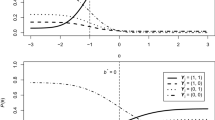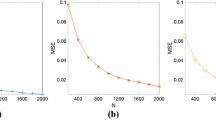Abstract
Cognitive diagnostic models are a powerful family of fine-grained discrete latent variable models in psychometrics. Within this family, the DINA model is a fundamental and parsimonious one that has received significant attention. Similar to other complex latent variable models, identifiability is an important issue for CDMs, including the DINA model. Gu and Xu (Psychometrika 84(2):468–483, 2019) established the necessary and sufficient conditions for strict identifiability of the DINA model. Despite being the strongest possible notion of identifiability, strict identifiability may impose overly stringent requirements on designing the cognitive diagnostic tests. This work studies a slightly weaker yet very useful notion, generic identifiability, which means parameters are identifiable almost everywhere in the parameter space, excluding only a negligible subset of measure zero. We propose transparent generic identifiability conditions for the DINA model, relaxing existing conditions in nontrivial ways. Under generic identifiability, we also explicitly characterize the forms of the measure-zero sets where identifiability breaks down. In addition, we reveal an interesting blessing-of-latent-dependence phenomenon under DINA—that is, dependence between the latent attributes can restore identifiability under some otherwise unidentifiable \({\mathbf {Q}}\)-matrix designs. The blessing of latent dependence provides useful practical implications and reassurance for real-world designs of cognitive diagnostic assessments.
Similar content being viewed by others
References
Allman, E. S., Matias, C., & Rhodes, J. A. (2009). Identifiability of parameters in latent structure models with many observed variables. The Annals of Statistics, 37(6A), 3099–3132.
Balamuta, J. J., & Culpepper, S. A. (2022). Exploratory restricted latent class models with monotonicity requirements under PÒLYA-GAMMA data augmentation. Psychometrika, 66, 1–43.
Chen, Y., Culpepper, S. A., Chen, Y., & Douglas, J. (2018). Bayesian estimation of the DINA Q matrix. Psychometrika, 83(1), 89–108.
Chen, Y., Culpepper, S. A., & Liang, F. (2020). A sparse latent class model for cognitive diagnosis. Psychometrika, 85(1), 121–153.
Chen, Y., Liu, Y., Culpepper, S. A., & Chen, Y. (2021). Inferring the number of attributes for the exploratory DINA model. Psychometrika, 86(1), 30–64.
Chiu, C.-Y., Douglas, J. A., & Li, X. (2009). Cluster analysis for cognitive diagnosis: Theory and applications. Psychometrika, 74(4), 633–665.
Culpepper, S. A. (2015). Bayesian estimation of the DINA model with Gibbs sampling. Journal of Educational and Behavioral Statistics, 40(5), 454–476.
Culpepper, S. A. (2019). An exploratory diagnostic model for ordinal responses with binary attributes: Identifiability and estimation. Psychometrika, 84(4), 921–940.
de la Torre, J. (2009). DINA model and parameter estimation: A didactic. Journal of Educational and Behavioral Statistics, 34(1), 115–130.
de la Torre, J. (2011). The generalized DINA model framework. Psychometrika, 76, 179–199.
DeCarlo, L. T. (2011). On the analysis of fraction subtraction data: The DINA model, classification, latent class sizes, and the Q-matrix. Applied Psychological Measurement, 35(1), 8–26.
Fang, G., Liu, J., & Ying, Z. (2019). On the identifiability of diagnostic classification models. Psychometrika, 84(1), 19–40.
Gu, Y., & Xu, G. (2019). The sufficient and necessary condition for the identifiability and estimability of the DINA model. Psychometrika, 84(2), 468–483.
Gu, Y., & Xu, G. (2020). Partial identifiability of restricted latent class models. Annals of Statistics, 48(4), 2082–2107.
Gu, Y., & Xu, G. (2021). Sufficient and necessary conditions for the identifiability of the \(Q\)-matrix. Statistica Sinica, 31, 449–472.
Gu, Y., & Xu, G. (2022). Identifiability of hierarchical latent attribute models. Statistica Sinica, 6, 66.
Henson, R. A., Templin, J. L., & Willse, J. T. (2009). Defining a family of cognitive diagnosis models using log-linear models with latent variables. Psychometrika, 74, 191–210.
Junker, B. W., & Sijtsma, K. (2001). Cognitive assessment models with few assumptions, and connections with nonparametric item response theory. Applied Psychological Measurement, 25, 258–272.
Kern, J. L., & Culpepper, S. A. (2020). A restricted four-parameter IRT model: The Dyad four-parameter Normal Ogive (Dyad-4PNO) model. Psychometrika, 85(3), 575–599.
Kruskal, J. B. (1977). Three-way arrays: Rank and uniqueness of trilinear decompositions, with application to arithmetic complexity and statistics. Linear Algebra and its Applications, 18(2), 95–138.
Liu, C.-W., Andersson, B., & Skrondal, A. (2020). A constrained Metropolis–Hastings Robbins–Monro algorithm for Q matrix estimation in DINA models. Psychometrika, 85(2), 322–357.
Maris, E. (1999). Estimating multiple classification latent class models. Psychometrika, 64(2), 187–212.
Rupp, A. A., & Templin, J. (2008a). The effects of Q-matrix misspecification on parameter estimates and classification accuracy in the DINA model. Educational and Psychological Measurement, 68(1), 78–96.
Rupp, A. A., & Templin, J. L. (2008b). Unique characteristics of diagnostic classification models: A comprehensive review of the current state-of-the-art. Measurement, 6(4), 219–262.
Tatsuoka, K. K. (1983). Rule space: An approach for dealing with misconceptions based on item response theory. Journal of Educational Measurement, 20, 345–354.
Templin, J., & Bradshaw, L. (2014). Hierarchical diagnostic classification models: A family of models for estimating and testing attribute hierarchies. Psychometrika, 79(2), 317–339.
von Davier, M. (2008). A general diagnostic model applied to language testing data. British Journal of Mathematical and Statistical Psychology, 61, 287–307.
von Davier, M., & Lee, Y.-S. (2019). Handbook of diagnostic classification models. Cham: Springer.
Xu, G. (2017). Identifiability of restricted latent class models with binary responses. Annals of Statistics, 45, 675–707.
Xu, G., & Zhang, S. (2016). Identifiability of diagnostic classification models. Psychometrika, 81(3), 625–649.
Yamaguchi, K., & Okada, K. (2020). Variational Bayes inference for the DINA model. Journal of Educational and Behavioral Statistics, 45(5), 569–597.
Acknowledgements
This work is partially supported by NSF Grant DMS-2210796.
Author information
Authors and Affiliations
Corresponding author
Additional information
Publisher's Note
Springer Nature remains neutral with regard to jurisdictional claims in published maps and institutional affiliations.
Supplementary Information
Below is the link to the electronic supplementary material.
11336_2022_9886_MOESM1_ESM.pdf
Supplementary Material: The Supplementary Material contains the technical proofs of all the theoretical results. (pdf 273 KB)
Rights and permissions
Springer Nature or its licensor holds exclusive rights to this article under a publishing agreement with the author(s) or other rightsholder(s); author self-archiving of the accepted manuscript version of this article is solely governed by the terms of such publishing agreement and applicable law.
About this article
Cite this article
Gu, Y. Generic Identifiability of the DINA Model and Blessing of Latent Dependence. Psychometrika 88, 117–131 (2023). https://doi.org/10.1007/s11336-022-09886-2
Revised:
Published:
Issue Date:
DOI: https://doi.org/10.1007/s11336-022-09886-2




